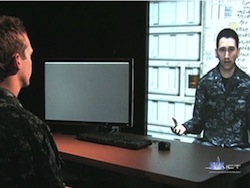USC Supplies Virtual Humans for Naval Leadership Training
- By Dian Schaffhauser
- 11/14/11

USC's virtual humans are designed to give Naval students practice in dealing with complex emotional problems. |
Practice makes perfect, or at least more effective. That's the thinking behind an initiative at the University of Southern California to use virtual humans to help train new leaders in interacting with and counseling the people under them.
The work is a project of USC's Institute for Creative Technologies (ICT). ICT, set up in 1999 with a multi-year contract from the United States Army, explores the use of interactive media and story-telling to improve training and education. One recent project for the US Navy, the Immersive Naval Officer Training System or INOTS, is a learning environment that blends traditional classroom instruction with virtual reality.
Currently, the environment is being used at the Officer Training Command in Newport, RI. There, virtual humans mimicking real human emotions and tension are being used to interact with officers in training to give them practice in resolving authentic and complex problems while instructors and other students watch in the background.
In one exercise, for example, a virtual sailor must face the wrath of his officer after getting into a shipboard fight with a fellow sailor. The virtual human can respond to the officer's words, raise his voice, or shake his head in frustration. He's just one of several characters created at ICT to respond with a multitude of emotions and actions. Other issues may include financial problems, domestic disputes, and on-the-job disputes.
According to the university, the recently installed prototype is believed to be the first time the military is using a life-sized virtual human for classroom training. While one student is interacting with the simulated sailor, other students in the class can participate by using clickers to select the action they'd take in a similar situation. That's followed up with an instructor-led evaluation and discussion of the interaction.
Previously, ICT said in a statement, students would practice interacting with another human being, such as an actor hired to play the part of a sailor or other students doing role-playing. The advantage of the virtual humans, ICT noted, was that they "offer consistent performances, can work nonstop in any location, and are equipped with software that allows for comparison and analysis of every exchange."
In addition to providing a consistent practice environment, the scenarios in the mixed reality environment have the flexibility to be reprogrammed and updated in the future to keep the training experiences fresh and relevant.
Another advantage of the INOTS approach: heightened student interest. According to ICT Research Associate Julia Campbell, naval students are told to stand up in the back of the class if they feel sleepy. During the recent training experiment, no one stood up. "They were completely engaged in the program," she said.
"Leadership training is about more than physical strength and giving orders," said ICT Creative Director Kim LeMasters. "Officers are often called upon to handle personnel problems but may lack the necessary skills and experience to be effective managers or counselors. Our system, which combines believable characters and powerful storytelling, provides a compelling way to improve how these trainees deal with interpersonal issues."
ICT also is developing an Army version scheduled to be delivered to Ft. Benning, GA., later this year.
About the Author
Dian Schaffhauser is a former senior contributing editor for 1105 Media's education publications THE Journal, Campus Technology and Spaces4Learning.